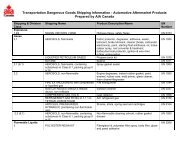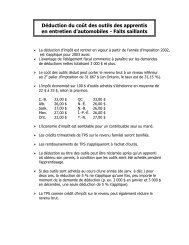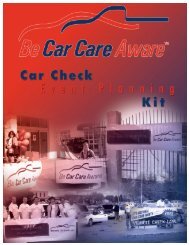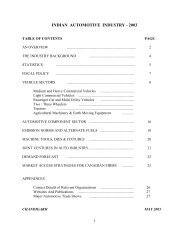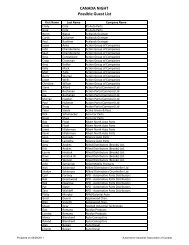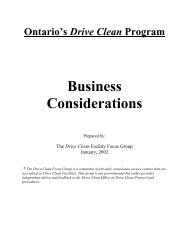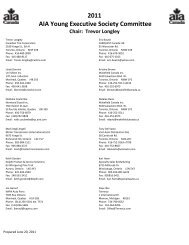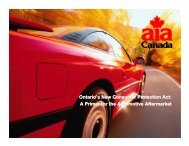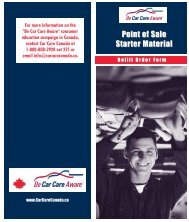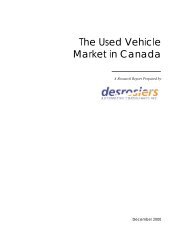Euro 5 Impact Assessment - Automotive Industries Association of ...
Euro 5 Impact Assessment - Automotive Industries Association of ...
Euro 5 Impact Assessment - Automotive Industries Association of ...
You also want an ePaper? Increase the reach of your titles
YUMPU automatically turns print PDFs into web optimized ePapers that Google loves.
2. PROBLEM DEFINITION2.1. Nature <strong>of</strong> the issue or problem that requires actionThe proper functioning <strong>of</strong> the single market in the <strong>Euro</strong>pean Union requires commonstandards limiting the emission <strong>of</strong> atmospheric pollutants from motor vehicles. Action atCommunity level prevents varying product standards emerging across Member Stateswhich results in fragmentation <strong>of</strong> the internal market and imposition <strong>of</strong> unnecessarybarriers to intra-Community trade. Also through harmonised standards it is possible toreap the economies <strong>of</strong> scale as production series can be made for the whole <strong>Euro</strong>peanmarket.Harmonized vehicle emission standards have long been a feature <strong>of</strong> EU policy. Givendevelopments in automotive technology, increased demand for road transport andcontinuing air quality problems, there has been a need to keep standards under review.2.2. Underlying drivers <strong>of</strong> the problemAll Member States and their citizens are concerned about the significant risk to humanhealth and environment that results from air pollution. Although air quality has improvedover the past decade, there are still significant air quality problems throughout the<strong>Euro</strong>pean Union, especially in urban areas and in densely populated regions. TheCommission’s Clean Air for <strong>Euro</strong>pe (CAFE) Programme 3 has identified that the pollutantsfrom road transport <strong>of</strong> most concern for human health are airborne particulates and ozone.Ozone is formed by reaction between HC and NO X , both <strong>of</strong> which are emitted by roadtransport. The road transport sector is a significant source <strong>of</strong> pollution; it was responsiblefor 43% <strong>of</strong> total NO X emission and 27% <strong>of</strong> total volatile organic compounds (VOCs)emissions in 2002. 4 The transport sector (including road transport, shipping, aviation andrail) accounted for 29% <strong>of</strong> total PM 2.5 emissions in the year 2000. 5 Road transportcontributed 15 % to the total emissions (i.e. from all sectors) <strong>of</strong> acidifying substances in2001 for EEA-31 (25 EU Members States, Bulgaria, Romania, Turkey, Iceland,Lichtenstein and Norway). Road transport is the dominant source <strong>of</strong> ozone precursors andcontributed 36 % <strong>of</strong> total ozone precursor emissions in 2001 in EEA-31 6 . Thesepollutants are associated with damage to health and have detrimental impacts onecosystems through: ozone formation; particulate matter formation; acidification andeutrophication. Since the emissions <strong>of</strong> these pollutants from motor vehicles areharmonised at EU level, the Community needs to address these issues, as it carriesresponsibilities for the internal market for vehicles, public health and the environment.3456Thematic Strategy on Air Pollution, COM(2005)446 final, 21.09.2005.Source: <strong>Euro</strong>stat – Environment and energy statistical data:http://epp.eurostat.cec.eu.int/portal/page?_pageid=0,1136239,0_45571447&_dad=portal&_schema=PORTAL.<strong>Impact</strong> <strong>Assessment</strong> <strong>of</strong> the Thematic Strategy on Air Pollution, SEC(2005)1133, 21.09.2005, p. 9, 26,31.EEA factsheet <strong>of</strong> air pollutants from transport:http://themes.eea.eu.int/Sectors_and_activities/transport/indicators/consequences/TERM03%2C2003.09/TERM2003_03_EEA31_Transport_emissions_<strong>of</strong>_air_pollutants_by_mode_final.pdf5



